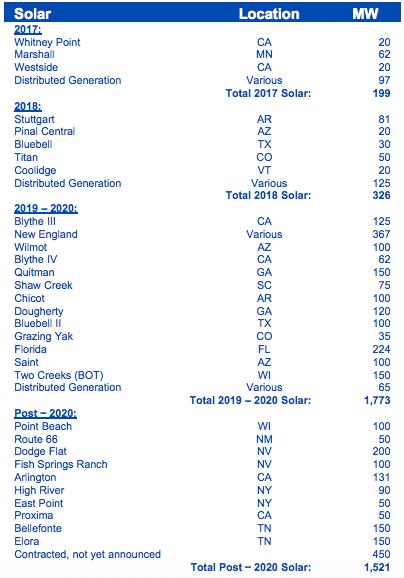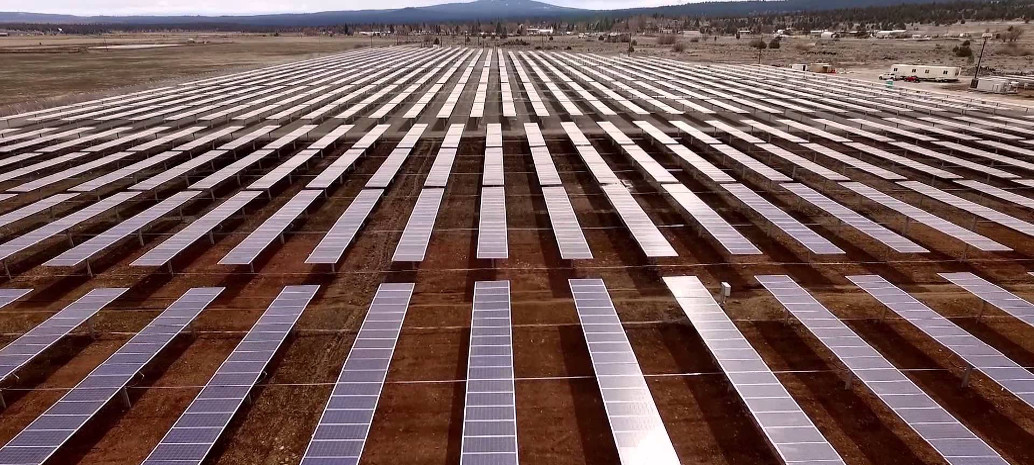Only one day after the U.S. Department of Energy’s Energy Information Administration (EIA) projected that coal’s decline will slow, gas will dominate the future energy mix and that wind will peter out after the PTC ends (our response here), one of the nation’s largest and arguably its most successful power companies has a very different forecast for the future.
In NextEra Energy’s fourth quarter results call, CEO Jim Robo dropped another bombshell, with his statement that solar and wind plus storage will be cheaper than coal, oil or nuclear, that this will be “massively disruptive to the conventional fleet” and that it will provide opportunities for developers well through the next decade.
Robo’s exact math is that even after the federal tax credits expire, wind will be 2 – 2.5 cents per kilowatt-hour, large-scale solar will be 2.5 – 3 cents, and storage will add .5 – 1 cent. This would put these resources slightly below the current cost of natural gas-fired generation, without the uncertainty around fuel prices that is inherent to gas.
Robo has been similarly optimistic about energy storage in the past, stating in a 2015 analyst conference covered by Greentech Media that “post-2020, there may never be another peaker built in the United States — very likely you’ll be just building energy storage instead.”
Ongoing growth in renewables
These comments came as NextEra announced results for a strong fourth quarter and full year 2018, including growing renewable energy development. NextEra Energy Resources, the company’s competitive power arm, put 326 MW of solar online, including 125 MW of distributed generation. This represents a more than 50% growth on 2017 installation levels, but the company is just getting started.
 NextEra already holds contracts for 1,773 MW of solar projects expected to come online in 2019 and 2020. Underlying the uncertainty around project development, it says that it could put anywhere from around 900 MW to 3.3 GW online over the next two years. Beyond that, NextEra also has 1,521 MW of solar projects which are slated to come online after 2020.
NextEra already holds contracts for 1,773 MW of solar projects expected to come online in 2019 and 2020. Underlying the uncertainty around project development, it says that it could put anywhere from around 900 MW to 3.3 GW online over the next two years. Beyond that, NextEra also has 1,521 MW of solar projects which are slated to come online after 2020.
The company’s energy storage development is also growing. While the company’s 37 MW of deployments in 2018 was only 23% larger than 2017, NextEra also has 50 MW of batteries planned for 2019-2020, and 415 in the post-2020 timeframe.
NextEra also put 1.4 GW of new wind projects online in 2018, and the company notes that it had the biggest year for origination to date, adding 6.5 GW of wind and solar projects to its backlog. But while wind is going to boom the 2019-2020 period, NextEra is looking at a longer runway for solar.
In particular, NextEra CEO Robo states that “IRS start of construction guidance on solar ITC positions us well for substantial solar and storage growth well into the next decade”.

FPL’s solar ambition
NextEra’s solar activity is not limited to its competitive power arm. Nine days ago NextEra subsidiary Florida Power and Light announced a plan to deploy 30 million solar panels – around 10 GW – by 2030. This includes pairing solar with battery storage, as the company is already doing, and during the call NextEra noted that it already has sites for 7 GW of these projects.
PG&E contracts
Despite the looming legal battle between NextEra and Pacific Gas and Electric Company (PG&E) over the indications that the California utility could try to modify legacy solar power contracts with NextEra-owned plants, the power giant expressed confidence.
In fact, it stated that while it will definitely fight for its contractual rights (including a proactive filing at FERC), NextEra still says that even in a worst-cast scenario, where it gets no further contributions from these projects, NextEra Energy Resources will still achieve its annual 12-15% growth in distributions in distribution through 2023.
This content is protected by copyright and may not be reused. If you want to cooperate with us and would like to reuse some of our content, please contact: editors@pv-magazine.com.









Peak capacity is the fake news of renewable energy. Your numbers should be average capacity not installed capacity. A 5000 megawatt Farm sounds impressive, until you realize it’s 20% annual average capacity, and no storage as an integral part of the package
I’m sorry if you are having a hard time telling the difference between capacity and energy, but the energy industry measures new installations in capacity, for multiple reasons. One is that capacity is a hard number and energy is only speculation when a plant goes online.
Wind and solar installations are not the only plants that have capacity factors below 50%. Natural gas peakers are usually generating power only in times of peak demand, and in New England coal and petroleum-fired generation usually only comes online during cold spells when gas supply is limited.
Also, new offshore wind plants sometimes have 12-month capacity factors above 50%. http://energynumbers.info/uk-offshore-wind-capacity-factors
Ultimately energy and capacity are simply different things, and if you or people you know are drawing false conclusions by capacity numbers, that isn’t our problem.
Hi, Mike, I was surprised the last time I looked into actual operating history of the nuclear plant in CT that they had years down around 30% CF, so I guess you should not be impressed by their nameplate vs. average capacity either. The future holds two pretty hard facts for conventional generation relative to real CF that IMO are under appreciated: 1) the availability of water cool enough to provide cooling is going to be a growing issue in various ways (including what else can we do with water where it is scarce ), 2) when you get to truly significant geographic diversity (and size diversity and connection to T vs. D) along with 30% to 50% renewables in an ISO territory AND you have a real dataset of years of operating characteristics vs. weather with granular real-time to back it up AND any significant amount of storage on the system on either side of the meter – well, what exactly does conventional generation offer as a big advantage to the system? Sorry if you don’t like the trendline, but we are headed to that state of affairs very fast (if not fast enough). I mean really, this is math and it is coming. If I were in a conventional generation business, I’d be cheering on electric vehicle adoption in a BIG BIG way and setting cheap overnight charging rates for EV owners just to keep the asset relevant outside of some seasonal conditions so my CF had a purpose.
Mike you’ve committed yourself to utility speak. The TESLA energy storage system constructed at the Neoen wind farm in Australia has proven itself immensely useful in keeping the grid up and stable.
The Australians call the old coal fired utility pundits (coalies) or the (coal-ilition). The coal fired plant management dismissed the TESLA 100MW energy storage system as a “six minute” solution to the grid. Since it was installed at the end of 2017, the energy storage system has: Kept the grid up and out of cascading failure when an old coal fired plant shutdown unexpectedly. The energy storage with the wind farm kept the grid up and running until the coal fired plant was reset and put back online. Responded to sags and surges along the grid, keeping the grid stable and the power delivery smoothed out during these spikes and sags. The energy storage system with the wind farm has been used when a main feed line had to be taken down for repair, replacement of components.
The bank that loaned $66 million to construct the TESLA energy storage system says the Wind farm has made $17 million in ancillary grid fees the first year of operation. So, paid for in about 4 years and after that it is profit for the wind farm and operators. (IF) this storage facility lasts for 10 years, the technology to replace it may even be cheaper or last longer than the current facility. How long does it take to amortize a coal fired plant? A natural gas fired plant? You do realize that energy storage is generation neutral and it doesn’t matter where the power comes from? So, with distributed energy storage constructed along the grid infrastructure one can also use the energy storage to allow conventional power plants to operate in a money making mode of operation over a 24 hour period?